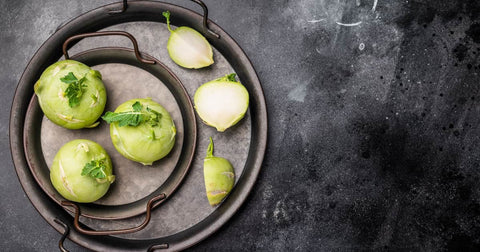Kohlrabi, a lesser-known vegetable with a distinctive appearance, is gaining popularity among health-conscious individuals. This cruciferous vegetable, with its mild, slightly sweet flavor and crunchy texture, offers a surprising array of health benefits.

If you're looking to add more variety and nutrition to your diet, this article explores the key benefits of kohlrabi, its versatility in the kitchen, and potential considerations for those with food sensitivities.
What is Kohlrabi?
Kohlrabi is a biennial vegetable belonging to the same family as broccoli, cauliflower, and cabbage. It's characterized by its bulbous stem, which can be green or purple, and its crisp, juicy flesh.
Is Kohlrabi Good for You?
Yes, kohlrabi is a very healthy vegetable. It's low in calories and a good source of essential nutrients, including:
-
Vitamin C: A potent antioxidant that supports immune function and skin health.
-
Fiber: Promotes digestive health and helps regulate blood sugar levels.
-
Potassium: An electrolyte that helps regulate blood pressure and fluid balance.
-
Glucosinolates: These sulfur-containing compounds have potential anti-cancer properties.
Kohlrabi Nutrition: A Closer Look
Kohlrabi is not only delicious but also a nutrient-dense food. One cup of raw kohlrabi (about 135 grams) contains approximately:

-
Calories: 36
-
Carbohydrates: 8 grams
-
Fiber: 5 grams
-
Protein: 2 grams
Kohlrabi Health Benefits: Beyond the Basics
1. Supports Immune Health:
The vitamin C and other antioxidants in kohlrabi can help strengthen your immune system and protect against infections.
2. Aids Digestion:
The fiber in kohlrabi can help regulate bowel movements and prevent constipation.
3. May Reduce Inflammation:
Kohlrabi contains glucosinolates, which have anti-inflammatory properties and may help protect against chronic diseases.
4. Supports Heart Health:
The potassium and fiber in kohlrabi can help lower cholesterol and blood pressure levels, promoting cardiovascular health.
5. May Aid in Weight Loss:
Kohlrabi is low in calories and high in fiber, making it a filling and nutritious addition to a weight loss diet.
6. Versatile and Delicious:
Kohlrabi can be enjoyed raw or cooked and adds a unique flavor and texture to various dishes.
Benefits of Kohlrabi: A Versatile Vegetable
Kohlrabi can be enjoyed in various ways:

-
Salads: Add shredded or sliced kohlrabi to your salads for a crunchy and flavorful addition.
-
Slaws: Use kohlrabi in slaws for a unique twist on a classic dish.
-
Stir-fries: Add chopped kohlrabi to your stir-fries for extra nutrients and texture.
-
Roasted: Roasted kohlrabi makes a delicious and healthy side dish.
-
Soup: Add kohlrabi to soups for a nutritional boost.
What Does Kohlrabi Taste Like?
Kohlrabi has a mild, slightly sweet flavor, often compared to a cross between broccoli stem and apple.
Nutritional Value of Kohlrabi: A Nutrient-Dense Choice
Kohlrabi is a low-calorie, nutrient-dense vegetable that's a good source of fiber, vitamin C, potassium, and glucosinolates.
Food Intolerance and Digestive Health
While kohlrabi is generally well-tolerated, some individuals might experience digestive issues after consuming it. This could be due to a food intolerance or sensitivity to cruciferous vegetables.
Food Sensitivity Test Kit: Identify Your Triggers
If you experience digestive discomfort after consuming kohlrabi or other foods, consider taking a food sensitivity test kit. This can help you identify specific foods that might be triggering your symptoms, allowing you to make informed dietary choices and improve your gut health.
Key Takeaways:

-
Kohlrabi is a nutritious and versatile vegetable with various health benefits.
-
It can support immune function, digestion, heart health, and weight management.
-
If you experience digestive issues after consuming kohlrabi, consider a food sensitivity test to identify potential food intolerances.
Remember, this article is intended for informational purposes only and should not be considered a substitute for professional medical advice. If you have any concerns about your health or dietary choices, consult a qualified healthcare professional.
Frequently Asked Questions:
1. How do I choose and store kohlrabi?
Look for kohlrabi bulbs that are firm and heavy for their size, with smooth skin and no signs of bruising or damage. The leaves should be crisp and vibrant green. Store kohlrabi in a plastic bag in the refrigerator crisper drawer for up to a week.
2. Can I eat the leaves of kohlrabi?
Yes, the leaves of kohlrabi are edible and nutritious. They can be cooked similarly to spinach or kale and added to stir-fries, soups, or salads.
3. What are some creative ways to use kohlrabi in recipes?
Kohlrabi can be enjoyed raw in salads or slaws, or cooked in various ways, such as roasted, steamed, or stir-fried. You can also use it to make fritters, noodles, or even a healthy substitute for french fries.
4. Is kohlrabi a good option for people with diabetes?
Yes, kohlrabi is a good choice for people with diabetes. It's low in calories and carbohydrates and has a low glycemic index (GI), meaning it won't cause a rapid spike in blood sugar levels.
5. I'm experiencing digestive issues after eating kohlrabi. Could it be a food intolerance?
Yes, it's possible to have a food intolerance or sensitivity to kohlrabi, especially if you're sensitive to other cruciferous vegetables like broccoli or cabbage. Consider a food sensitivity test to identify potential triggers and make informed dietary choices.


.png?v=1737390083)
.png?v=1737187409)


